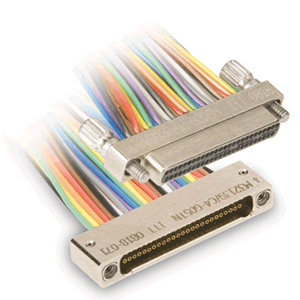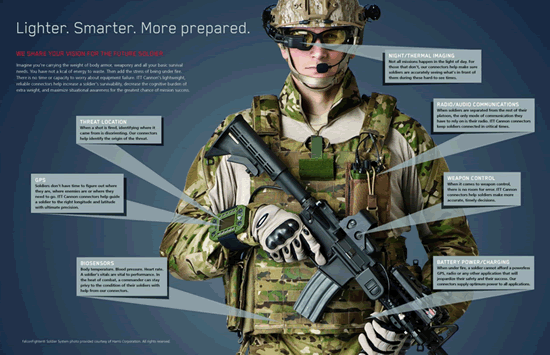Keeping the Future Soldier Connected
Utilizing modern technology to build efficient integrated equipment, electronics manufacturers ensure that the future soldier maintains constant contact to receive crucial, mission-critical information. Here are some big ideas from ITT Cannon for keeping the future soldier connected.
With continuing developments in technology, a soldier’s equipment must stay that much more ahead of these advances. Utilizing modern technology to build efficient integrated equipment, electronics manufacturers ensure that the future soldier maintains constant contact to receive crucial, mission-critical information. Today it is imperative that military technology supports emerging high-speed protocols; creates connectors that are faster, smaller, and lighter-weight, with increased power and bandwidth for better transfer of intelligence; and ultimately to maximize their chance of mission success.
Here are three of the most prevalent interconnect trends that are connecting the future soldier:
A movement toward miniaturization/smaller form factors: Depending on the mission, today’s soldiers carry an average load of 87 to 127 pounds on extended foot patrols which, according to the Department of Defense, have resulted in increased musculoskeletal injuries. For every one-pound decrease off their equipment loads, they can shave two seconds off their time. In combat, those seconds can mean life or death.
The trend toward miniaturization, including smaller form factors and low-profile connectors, allows for a soldier’s physical load and cognitive burden to be significantly lighter, which can increase response time and range of motion and decrease fatigue. Design solutions for military applications should include customized interconnects made to the smallest form, so they fit into tighter spaces and accommodate a lighter equipment load without compromising power, performance, reliability, and durability.

ITT Cannon’s Nano DD double-row connectors are used for military applications requiring high-bandwidth data transmission.
High-bandwidth transmission: Most military transmissions today require high bandwidth to deliver robust data applications. Connectors need to provide the electrical characteristics to deliver exceptional high-bandwidth performance in a durable, rugged design that withstands harsh, high-shock, and high-vibration environments. Many connectors require 100% sealing for reliability in the harshest environments. Soldiers are rarely in one spot, and the industry is continuously moving towards more portable gear that can keep a soldier connected to a central communications hub. From GPS to thermal imaging, delivering reliable power and more mission-critical data in a lightweight, robust, and integrated package helps lighten a soldier’s physical load and helps her maintain contact with her team.
Future applications: There is an inherent need to continuously keep an eye on the future to ensure that connectors are also evolving and maturing with the latest technology. What is next in military applications? For a long time, the military has envisioned the implementation and use of wearable technology for a soldier’s on-body gear that is still lightweight, durable, reliable, and powerful. One of the most innovative applications in development is “smart textiles” – more specifically, smart vests. The focus is on connectors integrated into the fabric of the vest, where most of a soldier’s network is housed, further reducing weight and complexities of current military vests. Embedding customized lightweight connectors into clothing enables emerging applications such as biometric sensors and other bi-directional location applications.
A soldier’s need to focus on the battlefield spurs innovation geared toward safety and greater mobility. By developing advanced technologies that offer reliable, robust, durable, and powerful applications for the future solider, they can stay safe in the battlefield and improve mission success. The trends towards miniaturization, high bandwidth transmission, and development of future applications such as smart textiles, help keep the future soldier connected so he can accomplish the objectives of a mission while keeping him out of harm’s way.
About the Author
Wes Morgan is the director of product management at ITT Cannon and has been with the company for more than 10 years. Morgan has more than 20 years of experience in the aerospace industry, specializing in high-bandwidth interconnect systems, and holds degrees in industrial/data network engineering and business administration. He can be reached at[email protected].






